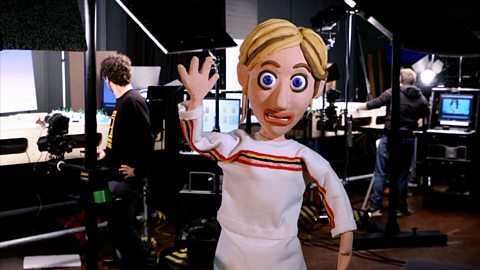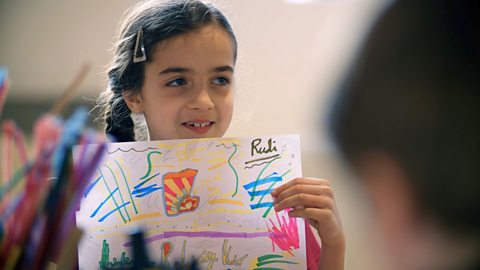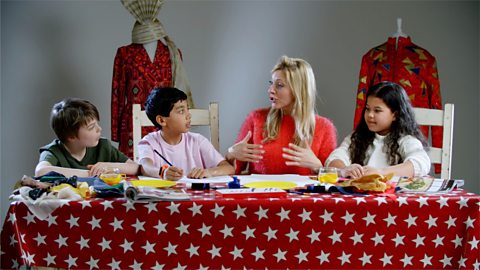Karim: Not too shabby, eh?
Karim: When you think of a sculpture, you might think of Anthony Gormley's 'Angel of the North'
Karim: Or you might think of the lions that guard Nelson's Column in Trafalgar Square.
Karim: And these are great examples, but that's not the whole story.
Karim: Sculptures are everywhere, even in the most unlikely of places… like here in this bakery!
Karim: A sculpture doesn’t have to be made out of bronze, stone or wood, it can even be made out of…
Karim: CAKE!
Karim: That's good! Who made this?
Karim: MEET THE MASTER!
Karim: Lily Vanilli is a professional baker and cake sculpture who makes all kinds of amazing creations.
Lily Vanilli: There are so many ways you can get creative with cakes and baking and so many amazing materials which you can use to create designs which are also delicious.
Lily Vanilli: You can get edible glitters, edible spray paints, food colouring, and you can also get fondant which is more or less like modelling clay.
Lily Vanilli: I like to make slightly weirder things like this edible heart which is actually really, really simple.
Lily Vanilli: There's no right way of doing it, it's just something I invented, and that's the fun with baking.
Lily Vanilli: You can just have a play around, make a mess and see what you come up with.
Lily Vanilli: So I'll show you how to use fondant. You want to start out by just making something like a sphere.
Lily Vanilli: Just roll it out in your hands and you'll get a smooth edge all the way around.
Lily Vanilli: To make the heart, I take a slightly bigger piece of fondant and a little bit of icing sugar just to stop it from sticking to the table.
Lily Vanilli: Roll it out…
Lily Vanilli: I'm going to use a piece of red velvet cake for the inside. Then just really fold these edges up and pinch them together so they stick. I've made this thousands of times, and it never comes out the same, but I'm always happy with how it looks.
Lily Vanilli: I think it's a really nice thing just to have a play around with and have fun with.
Lily Vanilli: Put that in the fridge, leave it to set and then I paint it with food colouring.
Lily Vanilli: So your challenge is to take a piece of fondant, any colour you like, and make yourself a cupcake topper.
Lily Vanilli: You can make anything you like, just experiment, have a play around and enjoy.
Karim: Thanks Lily, nice challenge! So, who's going to help me then?
Karim: First up, it's Corrina, and she is an art ninja!
Karim: Next, we've got Kian, who has a superpowered imagination!
Karim: And finally, it's Esther, who has super creative vision!
Karim: Guys, what do you think of this challenge?
Children: Love it! Best challenge ever!
Karim: Amazing! We'd better get started! You will need…
Karim: A pencil, paper and a rubber.
Karim: Fondant icing in lots of colours,
Karim: Sculpting tools and a stand or platform.
Karim: Right, first thing's first… I love this bit!
Karim: Let's sketch out some of our ideas! So grab a pencil, I'll dish out some paper…
Karim: …and Kian, talk to me! What are you thinking? What are you gonna put on top of your cupcake?
Kian: A space with a moon and sun in it.
Karim: What about you Korrina?
Korrina: I'm going to do a wraparound like Lily did!
Esther: I'm going to stick two holes in my cupcake and make cherries.
Karim: Amazing! Hey guys, do you know what I want to do? I want to do a skateboard coming of a ramp on top of my cake.
Karim: Do you think that's going to be possible?
Chrildren: YES!
Karim: Let's get started!
Karim: Use your pencil and paper to help plan what your sculpture will look like.
Karim: t's a great way to see what shapes you'll need to model when you're making your sculpture!
Karim: Right, now that we've developed our ideas, we get to make them! Sound good?
Children: YES!
Karim: You can play around with the icing. Roll it in your hands to make a sphere or use a flat surface to create a cube or an oblong shape.
Karim: And if it's not working, just eat it and start again!
Karim: These are looking awesome, well done guys!
Karim: Happy with what you did?
Karim: I think they look awesome! Now it's over to you guys to get creative!
Karim: Hey, fancy some cake?
Karim: Come on, off you pop! Let's go!
Karim: If you enjoyed this creative challenge, there are loads more on the Â鶹Éç Teach website!
Karim: You can write song lyrics, design a costume or even write a script for your favourite show.
Karim: So go on, get creative!
Video summary
Presenter Karim Zeroual is in a bakery trying his hand at some cake making.
Have you ever thought of cake decoration as art?
You might have noticed how elaborate and aesthetically appealing cakes can be, cake decoration uses many skills associated with art, such as design and sculpting. It is sometimes known as the sugar arts.
We meet Lily Vanili, baker and master cake decorator, who is going to show us how to make cake sculptures out of fondant icing.
Lily demonstrates how she makes her renowned heart cake, using red velvet sponge, fondant icing and food colouring.
Karim and a group of children take up the challenge to create a cake sculpture of their own.
We follow them through the process and then see their end creations.
This short film is from the Â鶹Éç series, Get Creative.
Teacher Notes
Before Watching
If you have opted to pre-make icing and/or cupcakes with the class these could be made as part of an earlier cookery lesson which incorporates maths and science skills.
Find one impressive image of a cake sculpture to show the class and discuss with the children whether they consider cake decoration to be art, why/why not?
Ask them to reflect on times when they have seen impressive cake design and to consider the skills that might be involved in creating something so elaborate.For example:
- Art Skills - design/drawing/3D sculpting/presentation
- Science Skills – baking/mixing ingredients
- Maths Skills – timing/measuring ingredients
After Watching
Ask pupils to sketch out some initial ideas for their cake sculptures, allow them to develop ideas around any theme or give them some guidelines.
This could be a stand-alone lesson with the children creating more in depth sketches that include colour and a short description of their design and theme.
Alternatively, this could be a quick task before sculpting.
Possible themes for sculptures could be:
- Make a cake sculpture inspired by a character from a story or poem
- Make a cake sculpture for your best friend’s/parents’ birthday, what would they like to see?
- Make a cake sculpture that links to a topic or theme e.g. Tudor design/Islamic patterns/pirates
Ask your pupils to consider which 3D shapes are included in their designs e.g. a head could be made from a spherical shape.
Demonstrate to the children how they can use tools to join parts of their sculptures together.
Allow the children time to create their sculptures and remind them that if they need to they can re-roll the icing and start again!
Master Skill(s)
Simplifying an idea into 3D shapes in order to make a sculpture.
Sculpting and joining 3D shapes.
Thinking Questions
- Which event are you making the cupcake sculpture for?
- What is the theme of your design?
- Which 3D shapes will you need to make in order to create your sculpture?
- Have you viewed your sculpture from all angles to make sure it looks 3D?
Supported Learning and SEN
This is a tactile activity which will make it very appealing and accessible to many children with SEN.
Provide children with as much support as required to complete the activity individually or in small groups if preferred.
Provide examples of 3D shapes that children can refer to when making their own, these could be sourced from maths resources or you could pre make some using the fondant icing or modelling clay.
Provide visual examples of possible cupcake toppers that can be formed using simple 3D shapes e.g. a cat made up of spherical shapes for body and head and cylindrical shapes for the legs and tails. You can source these through a simple internet search e.g. search for simple shape drawings of animals.
Extend this Project
You could extend this challenge by having children create cakes for an event that they organise, such as a community tea party or a charity bake sale.
They could choose the theme and event then spend time creating the overall aesthetic for the event e.g. bunting and table decoration.
Included in this could be maths and science lessons that incorporate baking their own cupcakes.
Children could review and evaluate their outcomes in small groups, discussing challenges encountered and what they would improve on next time.
Curriculum Notes
This short film meets and extends the current national curriculum requirements for art and design at KS1 and KS2 in England, Wales and Northern Ireland and at 2nd level in Scotland.
The film and lesson ideas will engage, inspire and challenge your pupils to explore their own ideas and produce creative work.
The short film introduces children to high quality skills and knowledge in art and design.
The challenge set supports children in becoming proficient in techniques including, but not limited to, drawing, painting and sculpture.
Through this series of short films, children will be introduced to and inspired by a range of artists, craftspeople and designers, they will experiment, invent and create work that links to the work of professional creatives.
Stop-motion Animation. video
Naomi Wilkinson visits an animation studio and shows us how to create our own stop-motion animation.

Product Design. video
A group of children are set a creative challenge to design a prototype product.

Costume Design. video
Naomi Wilkinson goes exploring in the costume department and challenges us to design our own costume.
